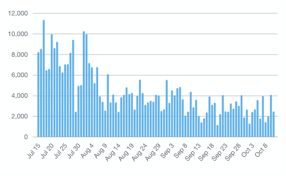- Outlier detection
- Trend analysis
- Data aggregation over time intervals
Time Series API
Explore our Time Series API for easily fetching ready-to-chart time series data.

ClickHouse function reference
seriesOutliersDetectTukey
Detects outliers in series data using Tukey’s fences method. Syntax:series(Arrayof numeric values): The input series data.min_percentile(Float64, optional): The minimum percentile for calculating the interquartile range (IQR). Default: 0.25. Must be in range [0.02, 0.98].max_percentile(Float64, optional): The maximum percentile for calculating the IQR. Default: 0.75. Must be in range [0.02, 0.98].K(Float64, optional): Non-negative constant to detect mild or stronger outliers. Default: 1.5.
Array(Float64)]
- At least four data points are required in the series to detect outliers.
- The function uses the interquartile range (IQR) method to identify outliers.
seriesPeriodDetectFFT
Finds the period of the given series data using Fast Fourier Transform (FFT). Syntax:series(Array(numeric)): An array of numeric values representing the time series data.
NaN when the number of data points is less than four. [Float64]
Example:
- The function requires at least four data points to detect a period.
- FFT is particularly useful for detecting regular patterns or cycles in time series data, which can be valuable for forecasting or identifying seasonal trends in taco sales or production.
seriesDecomposeSTL
Decomposes a time series into seasonal, trend, and residual components using the STL (Seasonal-Trend Decomposition Procedure Based on Loess) algorithm. Syntax:series(Array(numeric)): An array of numeric values representing the time series data.period(UInt32): A positive integer representing the expected periodicity of the seasonal component.
- Seasonal component
- Trend component
- Residual component
- Baseline component (seasonal + trend)
The number of data points in the input series should be at least twice the value of the
period argument.- The seasonal pattern of sales fluctuations
- The overall trend of increasing sales
- The residual (unexplained) variations
- The baseline sales (seasonal + trend)

